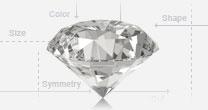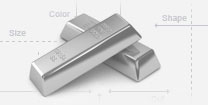- Diamonds
- Engagement
- Jewelry
- Education
- Learn about Diamonds
- Learn about Metals
- What to expect when buying a ring
- Custom Design Process
- The Diamond 4 C's
- How To Care For Your Jewelry
- How To Plan A Wedding
- Picking an Engagement Ring
- Top 10 Ways To Propose
- The Meaning Behind Shapes and Colors of Diamonds
- Advice for Grooms
- The Natural History, Mythology, and Symbolism of Popular Gemstones
- The Bridal Style Checklist
- The Economics of Engagement Rings
- How to Keep Your Diamonds Safe from Theft or Damage
- How to Create the Perfect Christmas Proposal
- The Secret Guide for Authentic Engagement Photos
- How to Plan the Perfect Marriage Proposal
- Best Seasons to Get Married In
- About Us
Diamond Clarity Guide
Out of all of the different diamond attributes, Clarity is the most straightforward and easiest to evaluate and understand.
In the process of formation, diamonds undergo tremendous heat and extreme pressue deep within the Earth's surface. These extreme conditions shape the diamond but also create imperfections in the carbon lattice. The impefections take on different forms such as cracks, small bubbles and fissures that can be internal or external to the diamond. The imperfections, or inclusions serve as unique identifiers for the diamond that make it different than any other diamond on the planet. Some inclusions can only be detected under powerful magnification and are not visible to the unaided eye. The industry relies on a standard of 10X magnification for assessing the diamond's clarity.
What Are Inclusions?
The irregularities in the diamond are called inclusions. Inclusions generally consist of feathers, crystals, and clouds. There are other forms of inclusions such as naturals (external imperfections) and knots (slightly below surface imperfections) and many others that are less common. Feathers are fractures in the diamond that do not compromise the strength of the diamond unless they are large and pervasive. Crystals look like small bubbles in the diamond that are small minerals that become trapped in the carbon lattice. Clouds are small foggy areas in the diamond that are comprised of very small crystals that are clustered together.
Clarity Grading
The globally recognized standard for diamond clarity assessment is comprised of 11 grades. Diamonds that have the least amount of imperfections are awarded the highest clarity grading. Flawless diamonds are particularly rare and exhibit no imperfections when viewed under 10X magnification. Flawless diamonds have no external or internal imperfections where IF or Internally Flawless diamonds may have very few external imperfections.
Gemologist use a 10X microscope to evaluate the diamond while viewing the diamond through its top. The size, position, and nature of the inclusions all play a role in determining the overall clarity grade of the diamond. Inclusions that are closer to the table are easier to detect and so are ones that are closer to the surface of the diamond. Larger and darker imperfections may also adversely affect the overall clarity rating of the diamond.
FL, IF Flawless/Internally Flawless: Flawless diamonds have no inclusions or blemishes detectable under 10x magnification, and are extremely rare. Internally flawless diamonds have no detectable inclusions under 10x magnification, are rare and very valuable.
VVS1/VVS2 Very Very Slightly Included: Inclusions and blemishes are extremely difficult for a skilled grader to detect under 10 x magnification.
VS1/VS2 Very Slightly Included: Inclusions and blemishes are detectable under 10x magnification, however they are minor flaws that do not impact the diamond's beauty and are frequently invisible to the naked eye.
SI1/SI2 Slightly Included: Inclusions and blemishes are easily noticeable under 10x magnification and may also be visible to the naked eye.
I1,I2,I3 Included: Inclusions and blemishes are obvious under 10x magnification and typically visible to the naked eye. These flaws may negatively impact the transparency and or brilliance of the diamond. These diamonds are not found on this site.
What Clarity Grade Is Right For Me?
The key to selecting the proper clarity grade is to finding one that agrees with your budget while creating overall effect that you want. SI and VS grades represent clarities that have outstanding value since they are generally (if not perfectly) eye-clean. Particulary well-cut diamonds will enable most customers to manage with lower clarities since they increased light-return of the diamond will mask the imperfections to a certain extent. It is often easier for a diamond that is not colorless (below F) to manage to hide its imperfections more effectively in the VS2-SI2 range since the contrast between the white diamond and the slightly colored imperfections is not as great.
Certain shapes such as the Emerald and Asscher have wide open facets that enable any viewer of the diamond to peer right into it. These shapes cannot generally "cope" with clarity grades under VS without showing flaws to the unaided eye.










